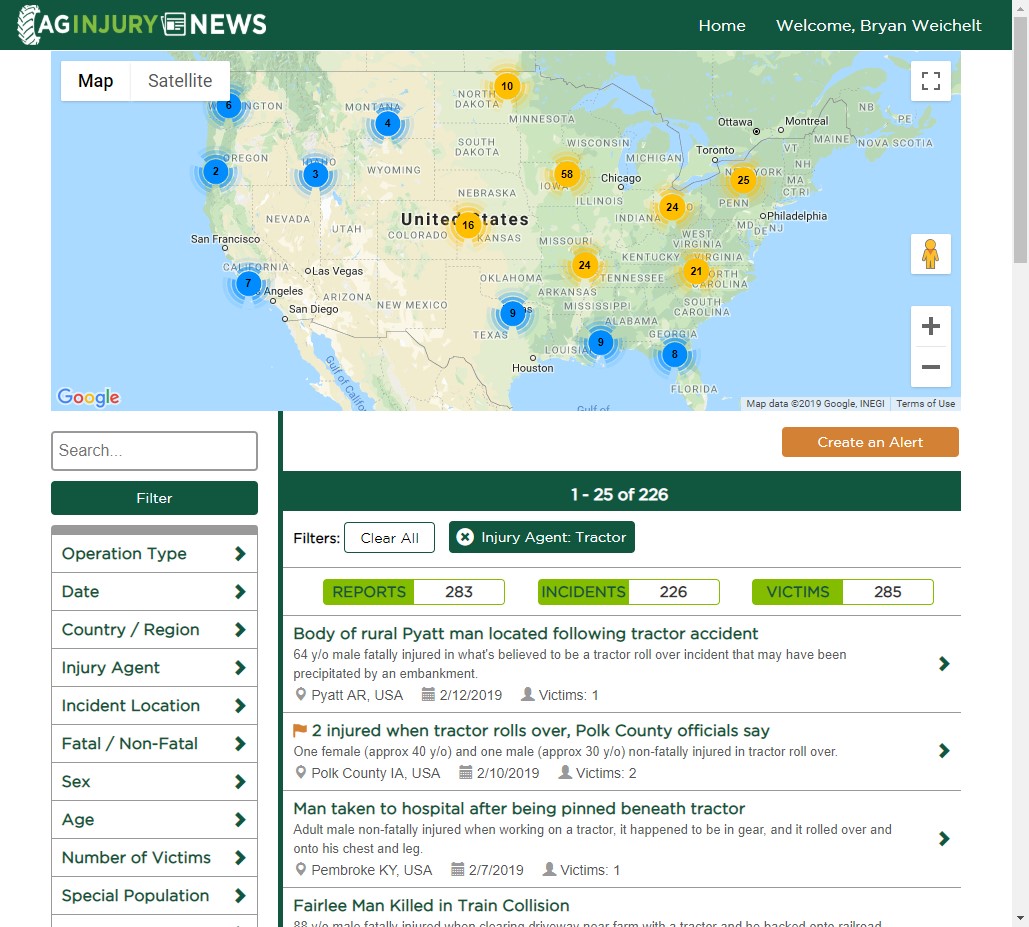 FOR IMMEDIATE RELEASE
FOR IMMEDIATE RELEASE
March 5, 2020
CONTACT: Scott Heiberger
heiberger.scott@marshfieldresearch.org
715-389-7541
Online database raises awareness of agricultural injuries
Published research on child injuries shows value of AgInjuryNews.org
An online tool is helping researchers see trends in agriculture-related injuries and offer safety solutions for farm families.
AgInjuryNews.org data indicate that children ages 6 and younger suffer a disproportionately high number of fatal injuries in farm-related incidents. The results are consistent with previous studies: little children can get into trouble and get injured very easily.
Largest public database of ag injury and fatality reports
AgInjuryNews.org is an interactive web-based system that anyone can use to search the largest database of publicly available agricultural injury and fatality reports. The reports include incidents involving adults as well as children.
Data are mined primarily from news media reports. AgInjuryNews.org uses web-crawling software to search for articles. Staff members sift through the results to find those related to agriculture, commercial fishing, and forestry injuries, then code and load the cases into the database. It offers a near real-time snapshot of the nature of incidents, across the U.S. and Canada.
“Media reports … have a unique way of moving people, much more than charts and numbers,” said project leader Bryan Weichelt, Ph.D., an associate research scientist with the National Farm Medicine Center, and National Children’s Center for Rural and Agricultural Health and Safety, Marshfield Clinic Research Institute. When trauma happens, families are forever changed.
The information contained in the database can uncover trends and point to potential solutions.
Report reveals young children at risk on farms
Weichelt led a team of researchers from across the nation, which used two years’ worth of data (2015-2017) to look at 255 incidents involving 348 youth injuries. They published their results in a research article (https://doi.org/10.1080/1059924X.2019.1605955) in the peer-reviewed Journal of Agromedicine.
- They found a disproportionate number of children ages 6 and younger died from farm injuries than victims in other age groups.
- The team also found that occupational and non-occupational injuries resulted in similar injury severities.
- The data also revealed that unsupervised children, especially youth ages 0 to 6 years, who were playing near vehicles, machinery, animals or farm structures faced an increased risk of injury.
In agriculture, the workplace often overlaps with the home, said Scott Heiberger, communications manager for the National Farm Medicine Center and current President of the International Society for Agricultural Safety and Health (ISASH). In fact, of children 10 and younger who are injured on farms, more than half are not working at the time of the injury.
“… (A)ttention should be given, and significant investment made, to keep young children out of the worksite,” the Journal of Agromedicine article reported. The data “have shown an increased vulnerability for young children in agricultural work environments. Yet, parents continue to place children in hazardous situations.”
Safety solutions designed for parents
A child dies in an agriculture-related incident about once every three days on a U.S. farm. To help empower parents in assigning appropriate work tasks to children, the National Children’s Center has created safety and educational materials including:
- The Ag Youth Work Guidelines help farm parents decide when their kids are ready for certain jobs. This website includes more than 50 common jobs a child could do in an agricultural setting. Posters for each job help parents decide if a child is ready based on development, not age.
- Prevention Briefs cover a variety of topics, including “Don’t mix worksite and child care.”
AgInjuryNews.org rooted in news clippings
AgInjuryNews.org was launched in 2015 as a way for the National Farm Medicine Center to store and access newspaper clippings. Media members would request data related to farm safety incidents, but Farm Medicine staff only had news clippings in binders. The director at the time suggested the clippings be converted to an electronic format.
Weichelt envisioned more than a spreadsheet, rather, a public website repository. Since its launch, the team has added new collaborators and partners, improved data collection and the coding and screening process. The website was redesigned in 2018.
Weichelt said he has held firm in not charging for the data or requiring subscriptions. AgInjuryNews.org offers open access to anyone who registers for a free account. It helps people stay informed about real-world cases and stories.
It’s a tool for many purposes
Ag producers and farmers use it as examples and talking points in safety meetings with employees. News reporters gather data, real-life incidents and contacts for their articles.
Insurance companies, county extension agents, FFA teachers and other educators can use it in their interactions with the farming community. Local fire departments and FFA chapters have used AgInjuryNews.org in their safety messages and training.
AgInjuryNews.org is also becoming a hub for keepers of regional data sets who are starting to talk and work together, Heiberger said, especially now that the federal government is doing less in tracking farm injuries.
“Surveillance done scientifically is expensive, and would be even more so trying to capture injuries on small family farms, where a disproportionate amount of the injuries occur,” Heiberger said, “so we feel as if AgInjuryNews.org is emerging at an important time.”
Raising awareness despite limitations
There are limitations to gleaning injury data from news reports. Not all agricultural fatalities are reported in the media, and non-fatal injuries are particularly underreported. Reports aren’t always complete. Despite limitations, from a prevention standpoint, AgInjuryNews.org is showing its value.
“One thing I think AgInjuryNews.org does well is take the ‘one here, one there’ nature of ag injuries and pull them together in a way that shows the scope of the problem(s) and emerging trends,” Heiberger said.
Weichelt said he’s most proud of “rejuvenating the importance of the prevalence of these types of cases to ag safety stakeholders from around the world.” Creating AgInjuryNews.org has taken research and reporting to a new level.
AgInjuryNews.org provides practical and pragmatic information, he said. A reporter working on an agriculture trend story can reference related cases in their state. That ability to search and find content didn’t exist before.
AgInjuryNews.org is creating “more awareness and interest, which can go a long way toward policy change,” Weichelt said. “We are helping move the needle.”
How to register
Anyone can set up a free account on AgInjuryNews.org and search thousands of unique incidents. To create an account, visit www.AgInjuryNews.org and click “Register.”
-- By Mystique Macomber
###

AgInjuryNews Logo (.jpg)
AgInjuryNews Logo (.png)

AgInjuryNews Screen Shot .(jpg)
AgInjuryNews Screen Shot .(png)
AgInjuryNews Screen Shot .(pdf)
